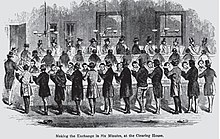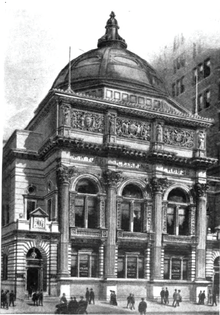The Clearing House is a banking association and payments company owned by the largest commercial banks in the United States. The Clearing House is the parent organization of The Clearing House Payments Company L.L.C., which owns and operates core payments system infrastructure in the United States, including ACH, wire payments, check image clearing, and real-time payments through the RTP network, a modern real-time payment system for the U.S.
Supporting services include The Clearing House Payments Authority (a payments association with over 1,000 financial institution members and corporate subscribers) and ECCHO (an entity develops and maintains rules that govern private sector check image exchange for its members, and also engages in lobbying and education).
Membership
Members of The Clearing House include JPMorgan Chase & Co., Bank of America Corp., Citigroup Inc., Bank of New York Mellon Corp., Deutsche Bank AG, U.S. Bancorp and Wells Fargo & Co. The Clearing House Payments Company, an organization owned by the same banks, was established in New York in 1853 for the purpose of processing transactions among banks. It has offices in New York, North Carolina, Texas, and Michigan.
- Bank of America
- Bank of the West
- Barclays
- The Bank of New York Mellon
- Capital One
- Citi
- Citizens
- Comerica
- Deutsche Bank
- Fifth Third Bank
- HSBC
- Huntington
- JPMorgan Chase
- KeyBank
- M&T Bank
- MUFG Union Bank
- PNC
- Regions Bank
- Santander
- TD Bank
- Truist
- U.S. Bank
- Wells Fargo
Lawsuits
In September 2009, the Clearing House joined a lawsuit in support of the Federal Reserve after a federal court in New York ruled against the Fed. Filed by Bloomberg News under the Freedom of Information Act, the lawsuit, Bloomberg L.P. v. Board of Governors of the Federal Reserve System, sought records showing where the Fed had lent $2 trillion of taxpayer funds during the bank bailout of the 2007–2008 financial crisis. The Clearing House has filed an appeal before the United States Supreme Court on October 26, 2010. The case was appealed but ultimately rejected on March 21, 2011. The Federal Reserve was required to release the data within five days to Bloomberg L.P.
The Clearing House was also sued by the State of New York in Andrew Cuomo v. Clearing House Association, LLC to determine whether the U.S. Treasury's Office of the Comptroller of the Currency (OCC) had the authority to preempt a state's right to enforce its own fair lending laws against national banks. A 5–4 decision by the Supreme Court overturned previous lower court decisions that had ruled in favor of the Clearing House and the OCC.
History

The New York Clearing House Association was a clearinghouse bank established in New York City in 1853. Initially, it simplified the chaotic settlement process among the banks of New York City. The New York Clearing House functioned as a quasi-central bank: setting monetary policy, issuing a form of currency, and even storing vaults of gold to back settlements. It later served to stabilize currency fluctuations and bolster the monetary system through recurring times of panic. Since the creation of the Federal Reserve System in 1913, it has used technology to meet the demands of an increasingly complex banking system.
Before 1853
In the decade before the Clearing House was founded, banking had become increasingly complex. From 1849 to 1853 –years highlighted by the California gold rush and construction of a national railroad system–the number of New York banks increased from 24 to 57. Settlement procedures were unsophisticated, with banks settling their accounts by employing porters to travel from bank to bank to exchange checks for bags of coin, or “specie.” As the number of banks grew, exchanges became a daily event. The official reckoning of accounts, however, did not take place until Fridays, often resulting in record keeping errors and encouraging abuses. Each day, the porters would gather on the steps of one of the Wall Street banks for their “Porters’ Exchange.”
Founding, 1853

In 1853, a bank bookkeeper named George D. Lyman proposed in an article that banks send and receive checks at a central office. There was a positive response and The New York Clearing House was organized officially on October 4 of that year. One week later, on October 11 in the basement of 14 Wall Street, 52 banks participated in the first exchange. On its first day, the Clearing House exchanged checks worth $22.6 million. Within 20 years, the average daily clearing topped $100 million. The current daily average approaches $2 Trillion.
The New York Clearing House brought order to what had been a tangled web of exchanges. Specie certificates soon replaced gold as the means of settling balances at the Clearing House, further simplifying the process. Once certificates were exchanged for gold deposited at member banks, porters encountered fewer of the dangers they had faced previously while transporting bags of gold from bank to bank. Certificates relieved the strain on the bank's cash flow, thus reducing the likelihood of a run on deposits. Member banks had to do weekly audits, keep minimum reserve levels and log daily settlement of balances which further assured more ordered, efficient exchanges.
Calming the panics, 1853-1913
Between 1853 and 1913, the U.S. experienced rapid economic expansion as well as ten financial panics. One of the Clearing House's first challenges was the panic of 1857. When the panic began, leaders of the member banks met and devised a plan that would shorten the duration of the panic–and more importantly, maintain public confidence in the banking system. When specie payments were suspended, the Clearing House issued loan certificates that could be used to settle accounts. Known as Clearing House Loan Certificates, they were, in effect, quasi-currency, backed not by gold but by discounted county and state bank notes held by member banks. Bearing the words “Payable Through the Clearing House,” a Clearing House Loan Certificate was the joint liability of all the member banks, and thus, in lieu of specie, a most secure form of payment.
The certificates appeared in smaller denominations during the panic of 1873, and continued to be used as a substitute currency among the member banks for settlement purposes during panics in subsequent decades, including the Panic of 1893. Although they represented a potential violation of federal law against privately issued currencies, these certificates, as a contemporary observer noted, “performed so valuable a service…in moving the crops and keeping business machinery in motion, that the government…wisely forbore to prosecute.”
In 1913, Congress passed the Federal Reserve Act, thus creating an independent, federal clearing system modeled on the many private clearing houses that had sprung up across America. The new monetary system, with its stringent audits and minimum reserve standards, assumed the role that clearing houses had played.
Clearing process during the 20th century
Since the inception of the Federal Reserve System, the New York Clearing House has concentrated on facilitating the smooth completion of financial transactions by clearing the payments. The clearing process, while highly structured, is in theory, quite simple. Member banks exchange checks, coupons and other certificates of value among themselves, after which the Clearing House records the resulting charges to their accounts. Entries are posted on the books of the Federal Reserve Bank of New York to settle any differences. Settlement is prepared each business day at 10:00 a.m. after about three million pieces of paper have been presented for payment.
Computers have been performing the payment clearing that once required paper processing. The Clearing House Interbank Payments System (CHIPS) began operation in 1970. The New York Automated Clearing House (NYACH) followed in 1975 and became the Electronics Payment Network in 2000. The Clearing House Electronic Check Clearing System (CHECCS) was added in 1992.
On July 1, 2004, The New York Clearing House Association announced a name change to The Clearing House Association L. L. C..
See also
- ACH
- Bankers' clearing house
- Clearing house
- Clearing House Interbank Payments System
- History of central banking in the United States
- Suffolk Bank
References
- John Stewart (2022). "Shrugging off the Impending FedNow, TCH Marks Five Years of Real-Time Processing Growth". Digital Transactions (published Nov 17, 2022). Retrieved 2022-12-10.
- ^ Bob Ivry, "Fed Loses Bid for Review of Bailout Disclosure Ruling" Bloomberg News (August 23, 2010). Retrieved March 10, 2011
- Martin Campbell-Kelly, "Victorian Data Processing", Communications of the ACM, Vol. 53, No. 10, October 2010, pages 19–21
- ^ Company description The Clearing House. Retrieved August 29, 2011
- Bob Ivry and Greg Stohr, "Fed Won't Join Supreme Court Appeal on Loan Disclosures" Bloomberg News (October 26, 2010). Retrieved March 10, 2011
- Amicus curiae (PDF) The Clearing House (March 2, 2011). Retrieved March 10, 2011
- Stohr, Greg; Ivry, Bob (2011-03-21). "Fed Will Release Bank Loan Data as Top Court Rejects Appeal". Bloomberg.com. Retrieved 2016-09-20.
- "Federal Reserve Emergency Loans: Liquidity for Banks". Bloomberg. Retrieved 2016-09-20.
- Adam Levitin, "Cuomo v. The Clearing House Association: OCC Loses Even with Chevron Deference" Credit Slips financial blog (June 29, 2009). Retrieved March 2, 2011
- NEW YORK CLEARING HOUSE Historical Perspective
- ^ "New York Clearing House Association Records, 1868-1950". Columbia University Libraries. n.d. Retrieved 22 June 2016.
- "Our History | the Clearing House".
- The Law of Electronic Funds Transfers by Benjamin Geva
External links
- Official Site
- The Clearing House Association's amicus curiae briefs
- American Banker feature on The Clearing House.
- Laying of the corner stone and opening ceremonies of the new building of the New York Clearing House in Cedar Street. Publisher: J.J. Little & Co., Printers, New York 1896 - Internet Archive - online
- New York Clearing House Association records, 1853-2006 Columbia University Libraries Archival Collection
Further reading
- Chernow, Ron (2001) . The House of Morgan: An American Banking Dynasty and the Rise of Modern Finance. New York: Grove Press. p. 125. ISBN 978-0802144652.